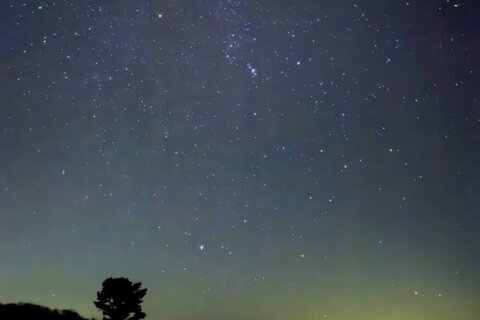NASA’s Wallops Flight Facility is scheduled to launch a rocket Thursday night that should be visible to the DMV as it climbs into the night sky.
The facility hopes to launch the 14th Northrop Grumman resupply mission to the International Space Station at 9:38 p.m. EDT, which will mean dark skies to look for the rocket. The Cygnus cargo ship (spacecraft) is the SS Kalpana Chawla.
The launch and mission will be carried live by NASA starting at 9 p.m. EDT on NASA TV and the NASA website.
Depending on where you are in the DMV, you might be able watch the rocket ascending into the sky with your own eyes. The visibility map for our area covers quite a bit of territory.

NASA has provided information on viewing locations near Wallops. It is possible to see the launch from Wallops’ Visitor Center and surrounding areas but traffic is very heavy during these launches.
Getting to an elevated location that looks to the east is your best bet. Binoculars will improve your view immensely.
Launch updates can be obtained via NASA Wallops Flight Facility Twitter and Facebook. There is also a nifty launch app, NASA WFF MISSION STATUS CENTER, you can check.
Weather prospects are 70% go for launch, but rain is forecast for the DMV. You should check for updates during the day.
The Full Harvest Moon occurs Thursday night at 5:05 p.m. EDT, and if there are some breaks in the clouds it will be a sight to see rising in the east at about 7:15 p.m. EDT.
This is the first of two full moons this month, with the Oct. 31 Full Hunter’s Moon being a “Blue Moon” and the smallest full moon for 2020.
If you are up before dawn on Oct. 2, be sure to check out the close pairing of brilliant Venus and the bright star Regulus in the east.
Also on Oct. 2, Mars and the bright moon will be close to one another as both rise in the Eastern sky at about 7:39 p.m. EDT. They will be visible and striking during the night.
Mars will be closest to Earth and brightest in our sky on Oct. 6 and at opposition, rising at sunset in the east Oct. 13. Mars is quite the sight and a peek will be worth your time.
To round out the month, the Orionid Meteor Shower will peak on the morning of Oct. 21. The meteors from this shower originate from famous Halley’s Comet and zip into our atmosphere at 41 miles per second! They are seen to radiate from the constellation Orion, the Hunter, which is visible in the southeast sky. Look a couple of nights before and bundle up and be comfy for the peak.
As you can see, there’s a lot to enjoy in the sky this month — if the weather cooperates.
Follow me on Twitter and my daily blog to keep up with the latest news in astronomy and space exploration. You can email me at skyguyinva@gmail.com.







